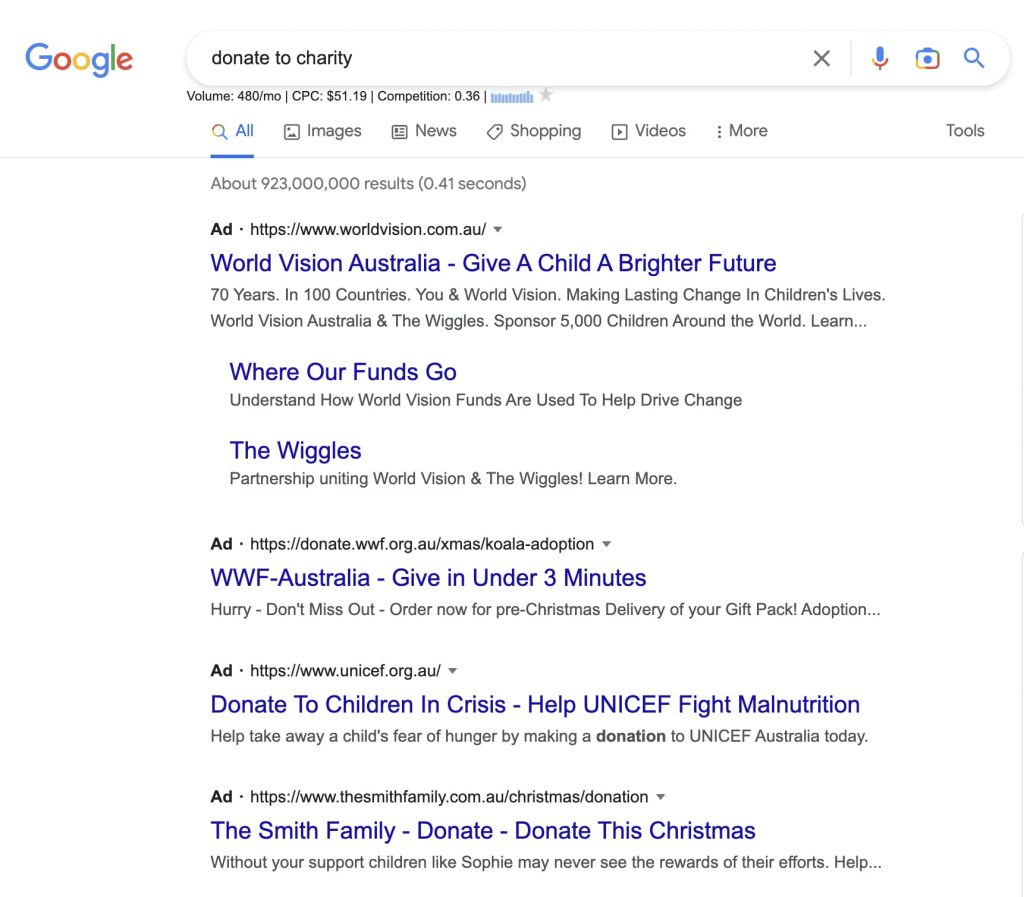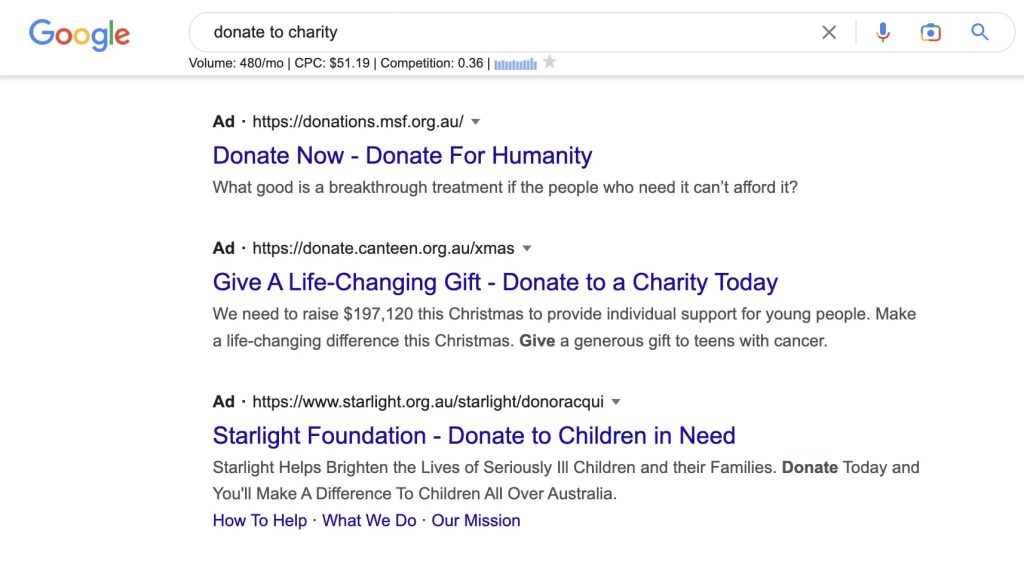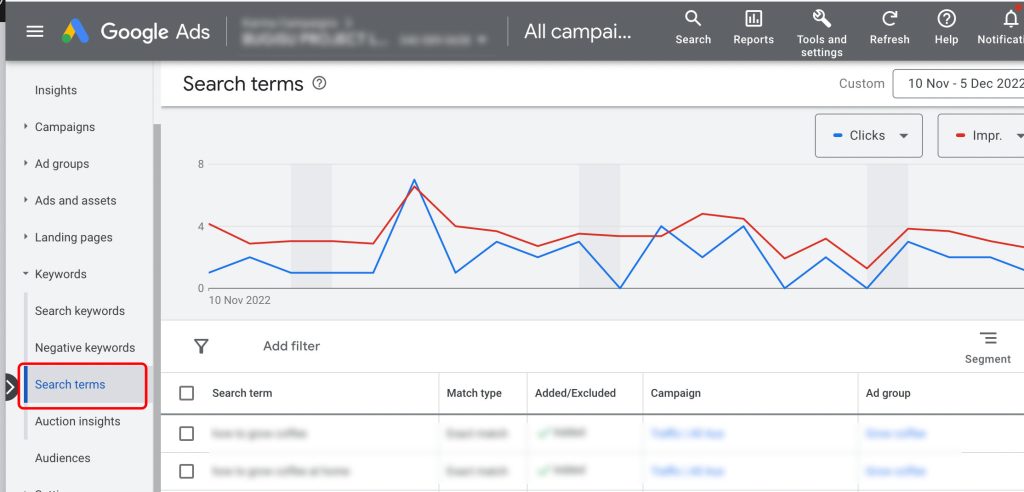Are Google Ad Grants worth it?
Will the time and effort it takes to set up and manage Google Ad Grant be worth it? It’s a question plaguing time-strapped nonprofit marketers everywhere. With a US$10,000 per month up for grabs, it certainly seems like a great deal. But is it really?
TL:DR version: Are Google Ad Grant worth it? Yes, it can be if you understand its limitations and are smart about using it in line with your broader marketing goals.
Understanding Google Ad Grant and its limitations
Google Ad Grants is an in-kind advertising program that awards free online advertising to eligible nonprofit organisations. Through the Ad Grants program, eligible nonprofits receive US$10,000 to promote their missions and initiatives through Google Ads.
There are some limitations. Firstly, you can ONLY use Google Ad Grant for search advertising. This is a search ad:

You can’t use your Google Ad Grant for other Google ad types, such as display, shop or video.
Secondly, search ads from paid Google Ad accounts will take priority over any Google Ad Grant ads. For highly competitive search terms, such as ones related to donations, organisations with the resource use paid account, and it can be tough to compete. A Google Ad Grant ad will only appear lower in search results and only if there are spots not filled by paid ads.
It’s impossible to know for sure, but for highly competitive search, such this one for ‘donate to charity’ I’d that all these ads…

… and all these ads appearing at the bottom of the results page…

… would have been created in paid Google Ad accounts.
What are the opportunities of Google Ad Grant?
Despite the limitation, there are huge opportunities to be taken advantage off with Google Ad Grant.
Google search ads can be a hugely effective way to reach potential supporters, volunteers, and donors and drive them to your website.
Worldwide 4.3 billion users worldwide, and it processes 40,000 searches every second.
On top of the sheer volume of Google reach, search ads present the opportunity to reach people with high intent.
What does high intent mean? It means you are reaching people actively seeking information or wanting to take a specific action. People looking for information related to your mission or trying to find out how to help your cause should be a priority for your marketing efforts.
Are there hidden costs to Google Ad Grant?
Not really. Your website must meet minimum standards before you are eligible for Google Ad Grant, so there could be costs in improving your website if it’s not there yet.
However, if your website doesn’t meet Google Ad Grant’s minimum standards, you should be taking action to fix this if you are serious about using your website to reach marketing or fundraising goals.
How long does it take to apply for, set up and manage?
The time it takes to apply for a Google Ad Grant Account could be as little as an afternoon, but it will depend on how tech-savvy you are and if you run into any roadblocks along the way.
To set up your account and first campaign, you will need time to conduct keyword research, write ads and set up your campaigns. It could be done in a day it you start small (I recommend this).
If you don’t already have conversion tracking set up in Google Analytics, you will need to do this, but again this is something your should do anyway.
You also need to monitor and optimise your account; however, how much time you take can be up to how much you have available. As little as 30 minutes every two weeks would be enough time to jump in, check results and make improvements. I recommend putting aside time in your diary.
How to make your Google Ad Grant worth it
So now we’ve looked at the limitation and opportunities, let’s talk about what you need to do to make sure your Google Ad Grant IS worth it.
Where search intent meets your marketing goals
Firstly, you want to align your campaigns to your overall marketing strategy. Focus on using it effectively, NOT on trying to spend every dollar for the sake of it.
When conducting keyword research, consider people’s search intent and where that might meet your marketing goals. For example, if someone is searching “What is feminism?” they may be new to the topic and looking for information for the first time. You could offer them great content that elevates your organisation as an authority on the topic.
If someone is searching “How to help refugees in Boston”, they are ready to take action; present them with an opportunity to sign up as a volunteer or donate.
Suppose someone has searched for your organisation name; they probably want to reach your website. You may think there is no value in showing these people a search ad (hopefully, your organisation appears at the top of organic search results). But your ad is an opportunity to direct people to the parts of your website you want them and spur them to action.
In my experience, traffic from Google Grant Ads can convert at higher rates than organic traffic to the same page,
Monitor and track results
Tracking meaningful conversions is a requirement of the Google Ad Grant and essential to making your Google Ad Grant worth it.
Once you have set up conversion tracking, you can optimise your ads using smart goals. This allows Google to use its algorithms and machine learning to show your ads to the people most likely to take action.
Using smart goals also allows you to get around the old US$2 bid limit.
But what should you track? This will depend on what your marketing goals are. For many organisations, donations and leads are important goals.
Don’t overlook brand awareness’s value and track first-time and returning users. Although these people may not complete lower-funnel goals, such as donating or signing up for your mailing list, they are still valuable visitors.
Users who are hearing about your organisation for the first time, getting to know you as an authority in your area or reading your stories of impact are one step closer to becoming donors, volunteers or advocates for your cause.
Take it slow and build your account over time
To make your Google Ad Grant worth it, you need to work on it.
Take it slow and don’t add thousands of keywords at once. Keep keywords tightly grouped in single-keyword ad groups with ads and landing pages relevant to the keywords and search intent.
Focus on finding opportunities to drive users along your marketing journey.
You will need to take time to improve your ads, run tests, and find more and even more keywords to target. Get started with our complete guide or view even more tips to optimise and improve your Google Grant Account.
Use your Google Ad Grant as a source of data
One final way Google Ad Grant is worth it, is as a great source of data.
If you’ve ever looked for keyword data in Google Analytics, you may be familiar with this sad report:

In your Google Ad Grant account, you can explore your search term report and see what people are actually searching before seeing your ads or landing on your website. Then tailor and create content that matches these searches, and drive even more traffic!

You can also find information about your users’ demographics and interests by creating audience segments.
Finally, you can use your Google Ad Grant data to know when you are not competitive for particular search terms (like ones related to donating) and consider setting these up in a paid ad account. If other organisations are doing this, there may be the potential to generate donations for your organisation.
In conclusion, are Google Ad Grants worth it?
If you have the time to work on it, then Google Ad Grants are worth it. With a well-defined marketing plan and the resources to manage it, the program could be a great way to get your message out.
If you have the budget consider using it alongside a paid account and get professional help to manage your accounts.


![Google Ad Grant: 9 Best Practice tips [2023]](https://karmacampaigns.com/wp-content/uploads/2022/07/Hero-Google-ad-grant-tips-768x511.jpeg)